Used Hyundai Tucson Quick Facts
- The best years for buying a used Hyundai Tucson are 2022 and newer.
- The Hyundai Tucson has one of the longest standard warranties in the business.
- This SUV offers a wide range of engines, including turbocharged and hybrid models.
The Hyundai Tucson wears many hats as a used compact SUV. Earlier models provide inexpensive and straightforward transport, while the newer ones are impressively sophisticated, both under the hood and in the cabin. A used Hyundai Tucson won’t cost as much as a Honda CR-V or Toyota RAV4; newer models may still have part of their warranty coverage. Better still, if you buy a Tucson that’s Hyundai Certified, the manufacturer reinstates the original 10-year/100,000-mile powertrain warranty from the original sale for the remainder of what’s left.
- What Is the Best Model-Year Used Hyundai Tucson?
- Hyundai Tucson by Generation: Which Should You Buy?
- Is the Hyundai Tucson a Good SUV?
- Does the Hyundai Tucson Have a Hybrid Option?
- How Much Can the Hyundai Tucson Tow?
- What Are the Most Reliable Years for the Hyundai Tucson?
- What Are the Worst Years for the Hyundai Tucson?
- Does Hyundai’s 10-Year/100,000-Mile Warranty Carry Over When Buying Used?
What Is the Best Model-Year Used Hyundai Tucson?
If you’re all about high-tech interiors, green powertrains, and sleek styling, the best years for a used Hyundai Tucson are 2022 and up. The fourth-generation Tucson offers a hybrid and plug-in hybrid electric vehicle (PHEV) option, advanced driver-assist systems, and a high-tech interior that puts all competitors to shame. If you’re looking to spend less money, the third-generation Tucson is also attractive, but some model years throw up a few red flags, requiring a bit more research before jumping in. The most notable of these factors is a massive recall for possible defective engines covering the 2017 model year and other engine and transmission issues covering the entire generation.
See used Hyundai Tucson SUVs for sale near you.
Hyundai Tucson by Generation: Which Should You Buy?
Fourth Generation: 2022-Current

The fourth-generation Tucson moves the compact SUV in a decidedly upscale direction. It’s larger, more powerful, and more sophisticated than the third-generation Tucson, making it our choice as the best-used option.
The dynamic styling makes this SUV stand out like no other. The same can be said for the interior, where a digital instrument cluster and infotainment touchscreen replace traditional analog gauges on all but the SE and SEL. A note for those who prefer more conventional knobs and hard buttons; you won’t find them on pre-2025 Tucson upper trim climate control, instead fitted with an annoying haptic touch design.
The non-hybrid trims employ a 187-horsepower, 2.5-liter 4-cylinder engine, which provides adequate power and fuel economy. The Tucson Hybrid and plug-in hybrid electric vehicle (PHEV) get a more powerful setup and standard all-wheel drive (AWD), combining a turbocharged 1.6-liter engine with two electric motors for a combined 226 hp and 268 hp, respectively.
The non-hybrid Tucson offers five trims: SE, SEL, N Line, XRT, and Limited. The hybrid models offer Blue, SE, SEL, SEL Convenience, and Limited.
The entry-level SE features LED headlights, analog gauges, an 8-inch touchscreen with wireless Apple CarPlay and Android Auto, cruise control, and remote keyless entry. It also features a full suite of driver assists, including forward collision warning and emergency braking, lane-keeping assist, automatic high-beam headlights, and a rear parking distance warning. A blind-spot monitor and rear cross-traffic alert are also standard, but adaptive cruise control requires going up one trim level.
The SEL adds adaptive cruise control, junction turning, heated side mirrors, rear privacy glass, an 8-way power driver’s seat, heated front seats, SiriusXM, and proximity keyless entry. The SEL trim also opens the door for more options, like a 10.25-inch digital cluster, Bose audio, and a panoramic sunroof.
The N Line adds a sporty touch with 19-inch wheels, unique front and rear styling, a Bose sound system, dual-zone automatic climate control, the 10.25-inch digital cluster, a wireless charging pad, and Hyundai’s Digital Key.
The Limited adds a panoramic sunroof, leather upholstery, ventilated front seats, a power passenger seat, memory driver’s seat, a 10.25-inch infotainment touchscreen with wired Apple CarPlay and Android Auto (you read that right; the more advanced touchscreen doesn’t include wireless connectivity until 2025), voice control for the climate control, a heated steering wheel, and rain-sensing wipers. Additional driver assists include Highway Driving Assist, a Blind-Spot View Monitor, a surround-view monitor, front and rear parking sensors, and rear automatic emergency braking.
The XRT gets unique 19-inch wheels, front and rear skid plates, H-Tex upholstery, and distinctive paint colors.
On the safety front, the Tucson earns a Top Safety Pick accolade from the Insurance Institute for Highway Safety (IIHS), including models from 2020 to 2025.
The fourth-gen Tucson is not without its issues. It has two recalls, one for a possible engine fire due to an overheated electric oil pump and another for a potential loss of power steering assist. The National Highway Traffic Safety Administration website has a complete list of Tucson recalls and complaints.
Some less common complaints for this generation include abrupt automatic transmission shifting and a few performance issues related to the touchscreen. Thankfully, Hyundai’s warranty should cover all these issues, provided it’s still in effect.
Model-Year Changes:
2025: Revisions include updated front and rear styling, a revised digital screen housing the cluster and infotainment systems, and an updated climate control panel.
2024: The N Line trim moves to a hybrid-only engine. New safety features include rear side airbags, front and rear seatbelt reminder chimes, and steering-wheel haptic feedback for lane-keeping and blind-spot monitoring. The SEL gains dual-zone climate control and an optional 10.25-inch screen.
2023: The SEL Premium package disappears, and the XRT trim debuts.
See 2022-to-current Hyundai Tucson SUV models for sale near you.
Third Generation: 2016-2021

The third-generation Tucson is larger and better equipped than the second. It offers more engine choices and safety features, including advanced driver assists on the top-line trims. There’s also more cargo space and rear-seat legroom, a more stylish dash design, and a new 5-inch and 8-inch touchscreen infotainment system.
Trims include the base SE, Eco, SEL, Sport, and Limited. The SEL and Sport trim packages vary slightly by year.
The SE’s standard engine is a rather anemic 2.0-liter 4-cylinder, putting out a mere 164 hp. The Eco, Sport, and Limited get a better 175-hp turbocharged 1.6-liter engine with a 7-speed automatic transmission.
The SE is modestly equipped with the basics, including air conditioning, power windows, cruise control, 17-inch alloy wheels, AM/FM/CD radio with iPod input, and Sirius satellite radio. The Sport is better equipped, offering features like a hands-free power liftgate, 19-inch wheels, proximity keyless entry, push-button start, a blind-spot monitor, rear cross-traffic detection, and heated front seats.
The Limited pulls out all the stops, with LED headlights, leather upholstery, a power passenger seat, navigation, and dual-zone automatic climate control. The Ultimate package, which later becomes a trim, adds automatic emergency braking, adaptive headlights, a panoramic sunroof, front and rear parking sensors, heated rear seats, ventilated front seats, and lane departure warning.
The 2017 Tucson is involved in Hyundai’s massive engine recall program, affecting the 2.0-liter and 2.4-liter Theta II engines. Owners report numerous issues, from stalling and misfires to complete engine failure. Early versions of the 2.4-liter engine are covered by an extended warranty to replace the engine due to connecting rod bearing failure, so if you experience an issue, it may be covered. Some 2016-2021 Tucson SUVs with the 2.0-liter engine also have an extended warranty, increased to 15 years or 150,000 miles. However, to qualify for the extended coverage on either engine, the vehicle must have a knock sensor update called a KSDS installed by the dealer. If you buy a used Tucson, be sure to visit your local Hyundai dealer to have this update performed.
Be aware that if you buy a used Tucson, the 10-year/100,000-mile powertrain warranty is pared back to five years/60,000 miles. However, if you buy a certified pre-owned (CPO) Tucson, the original warranty is reinstated from the date of its first issuance.
Model-Year Changes:
2021: No significant changes.
2020: No significant changes.
2019: The Tucson gets a mild refresh. New standard features include collision avoidance and lane-keeping. Hyundai drops the 1.6-liter turbo and replaces it with a 2.4-liter engine.
2018: Trim shuffling sees the Night and Eco dropped and SEL added. Apple CarPlay and Android Auto join the 7-inch touchscreen.
2017: The Limited trim gains Apple CarPlay and Android Auto, while the Eco and Sport gain rear seat air vents.
See 2016-2021 Hyundai Tucson SUVs for sale near you.
Second Generation: 2010-2015

Opting for a second-generation Tucson will get you a small compact SUV with limited cargo and rear seat space. The side window design limits visibility and creates a somewhat claustrophobic cabin, at least for the rear-seat passengers. These years also have a rather stiff ride. Don’t look for any kind of advanced driver aids here, although you will find things like traction control, front and side impact airbags, and anti-lock brakes.
Trims include the base GL, midlevel GLS, sporty SE, and top-line Limited.
This generation is motivated by a new 176-hp 2.4-liter 4-cylinder engine, which makes more power than the first generation’s V6. Base models get a less powerful 2.0-liter rated at 165 hp.
An older Tucson will likely have high mileage and may need a thorough inspection to ensure there are no normal wear and tear issues with components like the brakes, suspension, and driveline.
During this time, Hyundai and Kia issued several recalls covering the 2.4-liter engine due to the possibility of its connecting rods failing. Some 2010-2013 Tucson models may be affected. The extended warranty covers affected engines for 15 years or 150,000 miles from the date they entered service. This same extension applies to the 2014-2016 2.0-liter engine. As with the third-generation engines, Hyundai requires a software update to add KSDS knock sensor detection to the engine before honoring the extended warranty. If you purchase a used second-generation Tucson, take it to a Hyundai dealer to verify if the KSDS update has been performed. If not, the dealer will do it free of charge.
Model-Year Changes:
2015: No significant changes.
2014: Both engines gain direct-injection technology. New standard features include Bluetooth, a tilt/telescoping steering wheel, and reclining rear seats. Hyundai drops the GL trim and adds a new SE trim featuring a 4.3-inch touchscreen and rear backup camera.
2013: The GLS gains front fog lights, auto headlight control, and heated front seats. The Limited gains proximity keyless entry with a push-button start.
2012: The Tucson gets a revised suspension to help soften the ride.
2011: The low-priced GL trim arrives, featuring a 2.0-liter engine.
See 2010-2015 Hyundai Tucson SUVs for sale near you.
First Generation: 2004-2009

The first-generation Tucson isn’t a used SUV choice we’d advise. These early models have issues around the engines, transmissions, and overall build quality. Trim levels include the GLS, SE, and Limited (later becomes the LX). The GL features a 2.0-liter 4-cylinder engine and 5-speed manual transmission, while the GLS and LX use a 2.7-liter V6 mated to a 4-speed automatic.
See 2004-2009 Hyundai Tucson SUVs for sale near you.
Is the Hyundai Tucson a Good SUV?
Overall, Tucson SUVs make good used car choices, provided you are buying from 2018 to current models. They offer lots of cool features, have good crash test scores, and hold their value well. While there are some engine issues for certain years and models, Hyundai is quite good about honoring its warranty programs should you encounter an issue.
Does the Hyundai Tucson Have a Hybrid Option?
The Tucson offers a hybrid and plug-in hybrid option, beginning with model year 2022.
How Much Can the Hyundai Tucson Tow?
Tow ratings vary by generation. The third-generation Tucson can haul 1,500 pounds for the base SE and 2,000 pounds for all others. The same formula applies to the fourth-generation models, including the hybrids.
What Are the Most Reliable Years for the Hyundai Tucson?
The 2022 and newer models have proven reliable, with known issues covered by either a recall or service bulletin. The third-generation Tucson models have a few red flag years, with the 2016-2017 models being the years we’d skip over.
RELATED: Best Hyundai Santa Fe Years to Buy Used
What Are the Worst Years for the Hyundai Tucson?
Because of engine concerns and other problems, a late-model third-generation Tucson is probably the least desirable, although if you find one with a replacement engine, that might be a safe bet. For the second generation, 2010-2012 are the years we’d favor least.
Does the 10-Year/100,000-Mile Warranty Carry Over When Buying Used?
Although a used Hyundai Tucson powertrain warranty changes from 10 years/100,000 miles to 5 years/60,000 miles, that’s still a lot of coverage. However, if you buy a manufacturer-certified pre-owned (CPO) Tucson, Hyundai reinstates the original warranty from when the vehicle first entered service.
See Hyundai Tucson SUVs for sale near you.












I’m surprised at your suggestion that 2016/2017 cars have a red flag,we’ve got a 2016 1.7crdi mid spec model that despite a high mileage and a lot of heavy towing involved it is still fault free.Certainly the best car we’ve ever owned.